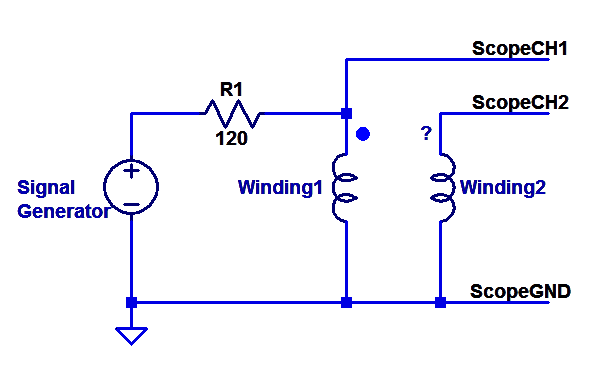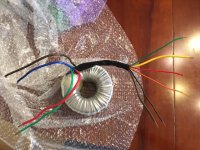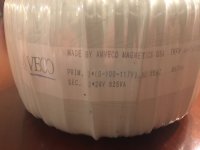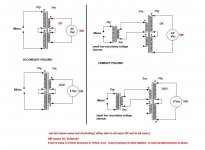Just bought this transformer off ebay. Plan on using it for an F5T build.
I just realized I have no idea what wire are what on the primary side. This is a 0/110/117 transformer. I need 117.
I know which are the secondaries (brown/blue, red/green) but the primaries have me confused.
I've got 6 wires of on the primary side which makes sense. But I don't know which ones are 0 and which are 117. Two of the primary wires (brown and yellow)have double runs of wire in them.
The datasheet does not match my wire colors. Perhaps this transformer is a custom job.
Anyone know?
I just realized I have no idea what wire are what on the primary side. This is a 0/110/117 transformer. I need 117.
I know which are the secondaries (brown/blue, red/green) but the primaries have me confused.
I've got 6 wires of on the primary side which makes sense. But I don't know which ones are 0 and which are 117. Two of the primary wires (brown and yellow)have double runs of wire in them.
The datasheet does not match my wire colors. Perhaps this transformer is a custom job.
Anyone know?
Attachments
You can use a DMM to measure the primary to find out 2 groups of 3 wires that are connected.
From each group, measure the resistances of all combinations of 2. The common color of the 2 highest resistance is the 0. Supposedly, the wire with the highest resistance to the 0 is the 117.
If you have a 6vac transformer like those for the vacuum tubes, you can feed the 6V AC to one the secondary pair and measure the VAC on the primary and deduct the primary using similar logic as above.
From each group, measure the resistances of all combinations of 2. The common color of the 2 highest resistance is the 0. Supposedly, the wire with the highest resistance to the 0 is the 117.
If you have a 6vac transformer like those for the vacuum tubes, you can feed the 6V AC to one the secondary pair and measure the VAC on the primary and deduct the primary using similar logic as above.
find which tappings are on which primary winding. Label them A or B for the two windings.
Then measure the resistance of the three alternatives A1 to A2, A1 to A3 and A2 to A3.
Find the highest resistance. That is the 0-117Vac tapping.
Find the lowest resistance. That is the 110-117Vac tapping.
Find the middle resistance. That is the 0-110Vac tapping.
Insulate the 110Vac tapping.
I suggest you insert each tapping into a separate receptacle of an insulated terminal block (safer with no loose wires flailing about).
Connect the 0Vac to Neutral
Connect the 117Vac to Live via a Mains Bulb Tester.
Switch on. You can now measure the voltages between all the other tappings.
Then measure the resistance of the three alternatives A1 to A2, A1 to A3 and A2 to A3.
Find the highest resistance. That is the 0-117Vac tapping.
Find the lowest resistance. That is the 110-117Vac tapping.
Find the middle resistance. That is the 0-110Vac tapping.
Insulate the 110Vac tapping.
I suggest you insert each tapping into a separate receptacle of an insulated terminal block (safer with no loose wires flailing about).
Connect the 0Vac to Neutral
Connect the 117Vac to Live via a Mains Bulb Tester.
Switch on. You can now measure the voltages between all the other tappings.
Thanks guys. I think I figured it out.
The primary leads with two wires (yellow and brown) are "0". They are the two ends of the 110 and 117 taps. The two leads have no continuity between them although they are in the same insulation. The black and orange are the 117 taps.
The primary leads with two wires (yellow and brown) are "0". They are the two ends of the 110 and 117 taps. The two leads have no continuity between them although they are in the same insulation. The black and orange are the 117 taps.
I tested with a bulb tester. Bulb did not light. I have 30.8v AC across each secondary pair. This is a 24v transformer. This seems ok? This voltage was taken with the bulb tester in place although Iam not sure it matters.
That secondary voltage is too high if the secondaries are supposed to be 24VAC with a nominal 117VAC primary supply voltage. It sounds to me as though you have connected the incoming AC voltage which is probably 120VAC or even slightly higher to the 100VAC primary tap.
Contact the manufacturer with the specific part number of the toroid for the correct primary connections if in doubt. It looks to me as though the details you show in your first post have different wire colours on the dual primaries to what is actually on the toroid you have.
Contact the manufacturer with the specific part number of the toroid for the correct primary connections if in doubt. It looks to me as though the details you show in your first post have different wire colours on the dual primaries to what is actually on the toroid you have.
Ok, tapped it a different way and I have 26.2v (24v transformer).
That sound better? Still not sure which primary is 0 and which is live but I guess it doesn't really matter.
That sound better? Still not sure which primary is 0 and which is live but I guess it doesn't really matter.
That is more like it, the sec volts will drop a bit based on the regulation % of the toroid once you load it.
check the voltage across the primary taps.Switch on. You can now measure the voltages between all the other tappings.
This lets you check you have wired them correctly.
I've got it up and running and connected to the cap bank. I am reading 34V rails unloaded. How much voltage drop can I anticipate when loaded (F5T, 2A bias)? Hoping for 32V rails.
Is the 34V the DC voltage at the amplifier power terminals, when the amplifier is set to zero bias current?
Or is it the voltage stored on the PSU capacitors when there is no load on the PSU?
Or is it the voltage stored on the PSU capacitors when there is no load on the PSU?
Is the 34V the DC voltage at the amplifier power terminals, when the amplifier is set to zero bias current?
Or is it the voltage stored on the PSU capacitors when there is no load on the PSU?
Measured at the last cap in the cap bank. The amp boards are not installed yet.
Then expect it to drop when you connect the amp. It might lose a couple of volts.
As you bias the output stage it will drop more, maybe 4 to 5 more volts.
i.e. 34 - (2+5) = 27Vdc
As you bias the output stage it will drop more, maybe 4 to 5 more volts.
i.e. 34 - (2+5) = 27Vdc
Additional options in this thread:
If you've got a signal generator and a scope,

(You could also use a protoboard + NE555 oscillator instead of the signal generator)
If you've got a signal generator and a scope,
(You could also use a protoboard + NE555 oscillator instead of the signal generator)
- Status
- Not open for further replies.
- Home
- Amplifiers
- Pass Labs
- Help me with this toroid!




